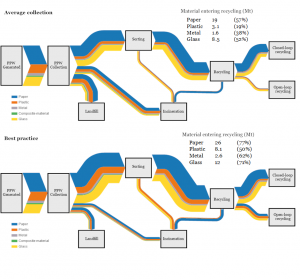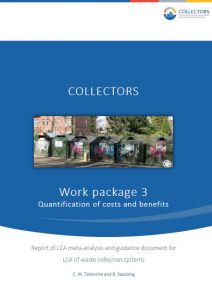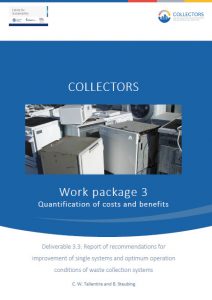Assessing the environmental impact of waste collection systems
12 case waste collection systems (WCS) across Europe were assessed from an environmental perspective applying the Life Cycle Assessment (LCA) methodology. This included 5 paper and packaging waste (PPW) cases, 5 waste electrical and electronic equipment (WEEE) cases and 2 construction and demolition waste (CDW) cases. The full report can be found here. A broad systemic perspective was adopted to capture the potential environmental impacts generated by the waste collection systems (WCS) as well as the consequences of quality and quantity of collected wastes for resource recovery and substitution of primary resources. Thus, the model covered the life cycle of the materials used in paper and packaging, electrical and electronic, and construction products: i.e. primary production, waste collection and sorting, as well as recycling and disposal (see Figure below). Closed and open-loop recycling were included as options to close material loops and substitute primary materials through recycled materials. The use phase of products is excluded, as it can be assumed not to change as a result of decisions at the WCS. Data was provided by stakeholders (interviews and questionnaires) and published data (i.e. scientific literature, national and regional reports, and a life cycle inventory database).

Figure 1: The scope of the assessment included the full life cycle (except for the use phase) of materials related to paper and packaging, electrical and electronic devices and construction materials. The focus was to analyze the importance of collection for the life cycle impact.
Reducing the environmental impact
We find that there is a substantial potential to reduce the environmental impacts for all materials analyzed through a better management of waste streams. The key to this is efficiency along the waste management chain, i.e. high capture rates, as well as high sorting and recycling efficiencies to reduce the recovery losses. In addition to increasing the quantities of waste, attention should be given to high value recycling, which is closely linked to material quality considerations in the collection, sorting and recycling of wastes. Individual results and recommendations for the 12 case studies are provided in the report.
The potential of best practices for climate change mitigation
In addition to the case study analysis, an assessment was performed for paper and packaging waste to see the effect of adopting observed best practices in the COLLECTORS project at the European scale. If all WCS across Europe would increase their PPW collection rates to those observed as best practice (i.e. increasing paper from 58% to 75%, plastics from 29% to 69%, aluminium from 37% to 61% and glass from 65% to 89%), an extra 18 million tonnes of waste could be collected annually in Europe (see Figure below), leading to a 13% reduction in greenhouse gas production associated with the packaging and packaging waste.

Figure 2: 18 million tons of paper and packaging waste could be additionally collected, if WCS were to adopt best practices in collection throughout Europe. [link to open access paper]
Relevant publications
To discover more on the selection of case studies, have a look at the following publications:
 D3.1 Report of LCA meta-analysis and guidance document for LCA of waste collection systems
D3.1 Report of LCA meta-analysis and guidance document for LCA of waste collection systems
This report provides a methodology and thus guidance for performing life cycle assessment (LCA) studies for waste collection systems. The methodology adopts a broad systemic perspective to capture not only the potential environmental impacts generated by the WCS themselves, but also the consequences for resource recovery and substitution of primary production inputs.
Executive summary available here
This report provides the environmental assessments of 12 case studies on waste collection in Europe, applying the Life Cycle Assessment method described in D3.1. It analyses how improving muncipal waste collection can reduce the environmental impact for the three waste fractions covered by the project.
